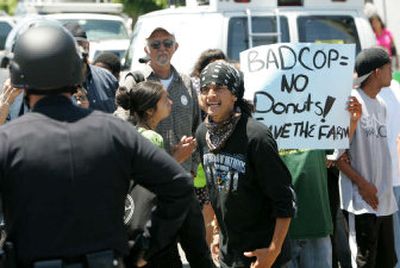Farmers evicted from urban L.A. farm

LOS ANGELES – The 14-year effort to establish an urban farm in the heart of south Los Angeles came to an end Tuesday when law enforcement officials moved in to evict the farmers, as well as some celebrities who were supporting them by keeping vigil on the land.
Deputies using a fire ladder removed actress Daryl Hannah and protest organizer John Quigley from the tree where they had vowed to remain as long as possible.
About 50 officers arrived at the property about 5 a.m. and used bolt cutters to remove locks and gain access to the 14-acre property. About 14 people had remained inside the farm, some chained under trees and others locking hands around 55-gallon drums filled with concrete.
Television broadcasts showed a large ladder extending from a firetruck reaching into the tree where Hannah, Quigley and two other people were located. Nearby, protesters were shown sitting on the street or sidewalk, many with their hands tied behind their backs as they were surrounded by police.
Several streets surrounding the farm were closed off by authorities.
Hannah said she was sleeping in her tent when the Los Angeles County sheriff’s deputies arrived. Quigley alerted her to the raid, and she raced up the tree.
“I felt an extreme sense of urgency. Not only did I have to climb up the tree, I had to pull up the rope behind me so they could not follow me,” Hannah said in a cell-phone interview with the Los Angeles Times from atop the tree.
Quigley criticized authorities for moving forward with the eviction without first telling the protesters. He said the protesters had a plan for how to peacefully resist an eviction when it came.
When the deputies arrived, Quigley said, some protesters walked out of the farm while others took their positions to block the eviction. “It’s unfortunate they had to come in such a heavy-handed manner,” he said.
The farm came to life after the 1992 riots, when the city leased the land to the Los Angeles Regional Food Bank.
Landowner Ralph Horowitz bought the land from the city in 2003 and, in recent months, has been trying to sell it. A nonprofit group tried to buy the land and preserve the farm. But it announced last month that its fundraising effort was $10 million short of Horowitz’s $16.3-million asking price.
Some in the community support him, arguing that the area would benefit from the jobs that would come if the land were developed.
The city acquired the land from Horowitz through eminent domain in the 1980s for a planned trash incinerator, but the project was stopped by neighborhood opposition.
After the 1992 riots, the city leased the land to the Los Angeles Regional Food Bank, which began the community garden. In 2003, the city sold the land back to Horowitz for about $5 million.
In recent days, organizers said they were close to finding another nonprofit that would purchase the land, but those plans apparently fell through.